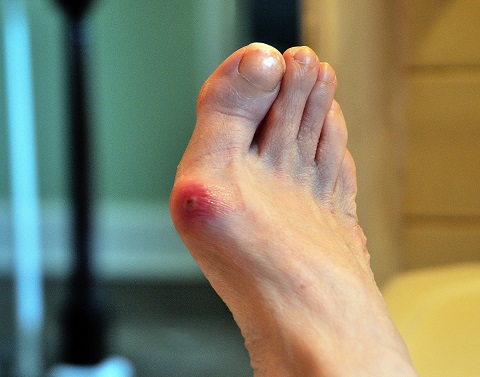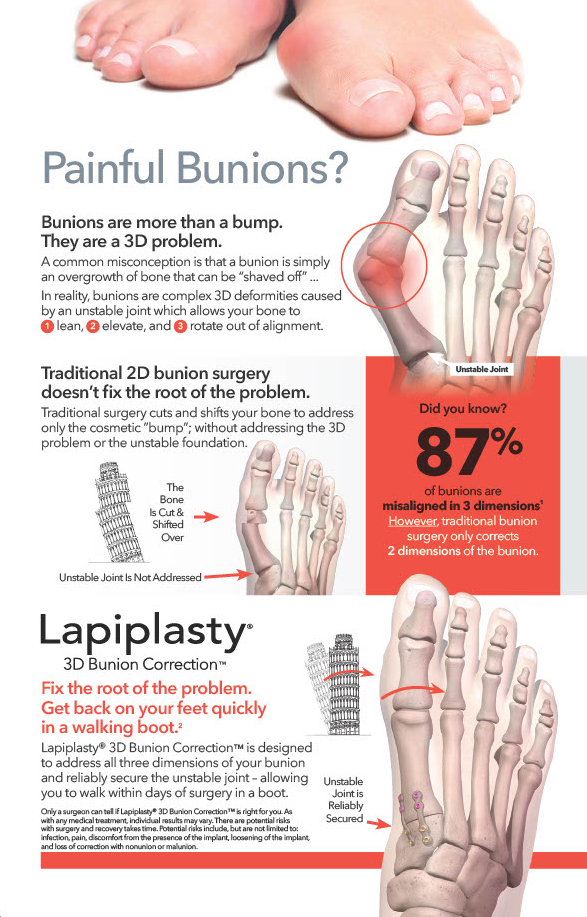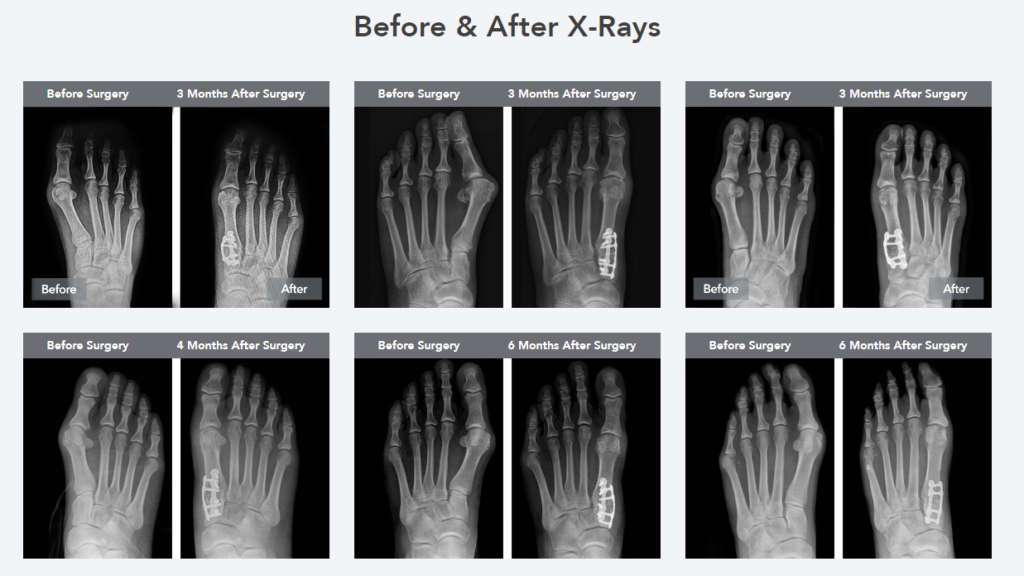Bunions are a type of foot deformity that can be unsightly and often very painful. Although commonly thought of as being caused by an overgrowth of bone, they are primarily caused by an increased angle between the first and second bones of your foot. The deformity causes the skin to rub inside shoes, and puts pressure on the bone, causing the bone to react by getting bigger, and forming a bursa, something similar to a blister, inside your foot
Bunion treatment consists of shaving off the excess bone, reducing the bursa, and putting the head of the metatarsal bone into a more correct position, in order to hold the great toe in alignment, and relieve pain.
Over 100 bunion treatments have been used over the years to resolve the problem, and they range from conservative to surgical. However, these treatments don’t always go far enough to bring relief to the sufferer, and many have lengthy healing times requiring the patient to be off their feet,
Patients who suffer from bunions now have a surgical option that puts the joint back into place, restores movement in less time, and returns patients to their normal, active lifestyles. The following is a look at this game-changing bunion surgery known as Lapiplasty.

How Bunions Happen
Bunions occur when the bones of the foot shift out of place and pull the big toe toward the smaller toes. The joint of the big toe becomes angled toward the inside of the foot, resulting in a large bump. The big toe slips the other way, pressing against its neighboring toe, and it eventually overlaps the adjacent toe if the problem persists long enough.
Bunions are primarily hereditary, but their formation may be increased by several outside factors including wearing tight and/or narrow shoes regularly, flattened (pronated) arches, loose ligaments in the foot, and even the shape of your foot. Ultimately, the result is the same in the form of an unstable joint that’s being pushed out of its natural position.
Treating Bunions the Traditional, Surgical Way
Surgical treatment for bunions generally involves cutting the bone of the first metatarsal, called an osteotomy, in order to reposition the metatarsal head and additionally, shaving away part of the bone that protrudes from the side of the foot. This treatment serves to reduce the size and appearance of the bunion and provide some pain relief, but it fails to address the condition’s root cause.
A simple osteotomy is considered a 2-dimensional surgery in that it’s applied to a single plane of the bone. In the case of a bunion, the side of the bone is shaved off, the metatarsal head is repositioned, and the joint is left untouched. Recovery after the surgery can take up to six months and isn’t a true correction of the problem. In fact, the bunion can return because the joint is being pushed farther out over time.

Why Lapiplasty Is a Revolutionary Treatment for Bunions
Lapiplasty is a 3-dimensional surgery in that it addresses the placement of the joint from all sides and angles. It uses a special tool to realign the joint, and titanium plates are screwed into the joint. The technique goes directly to the source of the problem and restores stability to the joint instead of making it look better without delivering much in the way of relief.
I started using the Lapiplasty system in 2020, and it quickly became my choice for performing the lapidus bunion repair procedure. The system works well, and gives me a highly stable result with early return to weight bearing.
-Dr. Bruce A Bever, DPM
The surgical process consists Dr. Bever accessing the joint, then putting a specialized instrument in place on the side of the misaligned metatarsal. The instrument consists of a brace and a post that applies pressure to the misaligned bone. Once the instrument is in place, Dr. Bever uses the jig to push the bone slowly and evenly into a corrected position.
Once the bone is in alignment with its neighboring joints, it is fixed into its new position with two low profile titanium plates that provide support against the pressure that you put on your feet as you walk. The plates are fixed into place with screws.
Over time, the plates fuse into your foot bones and become a permanent part of your body. This prevents the bunion from returning.
Getting Lapiplasty After a Traditional Bunion Surgery
You can get Lapiplasty even if you’ve previously undergone a traditional osteotomy for your bunion. There’s typically enough bone left in the joint for the titanium plates after a traditional bunion surgery has been performed.
The Lapiplasty procedure is precise and is done the same way every time, which means terrific consistency in how the procedure is performed and increases the potential for success even for someone who’s previously had an osteotomy on their bunion.
What Your Foot Looks Like After Lapiplasty
Your foot will be swollen in the days immediately following the procedure. However, you won’t be able to see the bunion because the joint has been put back into alignment. The result is that of your foot looking like it once did before the bunion formed and your toes moved out of alignment.

How Long Does It Take To Recover From the Procedure?
Most patients can begin to walk on the treated foot within days after the surgery. You may not be able to walk fully, but you can typically bear some weight on the foot and increase the pressure over the following days. This is in contrast to the eight weeks after a traditional osteotomy when you’d still be using crutches.
Most patients begin their recovery process by using crutches, a scooter, or occasionally a walker, for a short time, then graduating to a walking boot for the next four to six weeks. At six to eight weeks after the procedure, you can transition back into comfortable shoes, and the podiatrist monitors your progress to watch for complications.
Another benefit to the Lapiplasty procedure is the fact that you don’t have to wear special shoes or avoid wearing your regular shoes for weeks after you’ve healed. You can resume wearing your regular shoes once you’re cleared to take off the walking boot and start going back to your normal activities.
Are you interested in learning more about Lapiplasty and how it can help you eliminate your bunions? Give Dr. Bever a call to schedule an appointment for an evaluation, and find out how you can become bunion-free with Lapiplasty!
